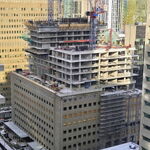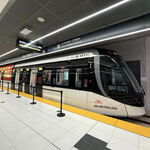amnesiajune
Senior Member
To me, for a street to be considered one of the city's best avenues it has to have, at a minimum:
That's just off the top of my head. Yonge Street in North York is none of these things.
- Consistently wide sidewalks made of something better than poured concrete riddled with asphalt patches.
- Planting beds and healthy street trees buffering the sidewalk from the traffic lanes. Think Dundas St next to the Eaton Centre or Michigan Ave in Chicago.
- No overhead wires.
- Infrastructure like traffic signals and streetlights that are nicer than the standard suburban design.
I can't really think of any street other than St. Clair West that's all of those things, and its sidewalks aren't consistently wide (it can be anywhere from 2 meters to 4 or 5 meters).
Think Dundas St next to the Eaton Centre
Sidewalk is narrow and not buffered, plenty of overheard wires, "standard suburban" traffic lights:

Who cares. FYI, short building do indeed exist here.
https://www.google.ca/maps/@43.7636...6MJCouuwr48I-qxSJzVA!2e0!7i13312!8i6656?hl=en
And a lot of the highrise buildings are set back on a podium of similar height.
I don't know what height limits there are in this area
I was just making a joke about how many recent developments (Emerald Park, Hullmark Centre, Gibson Centre, 88 Sheppard East, 21 Hillcrest) go to the OMB to get a secondary plan amendment for height limits, and how often those complaints get brought into the ReImagining Yonge discussion (especially by Filion and his anti-OMB colleagues). You can see all the sites that stand out here: https://www1.toronto.ca/planning/8-north-york-centre.pdf
Attachments
Last edited:




